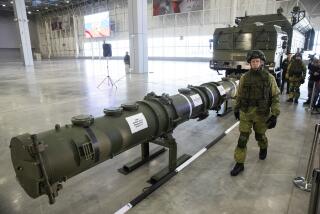Setting the Stage for Geneva
Secretary of State George P. Shultz is struggling manfully to repair the damage done by reckless Administration statements suggesting that the United States is prepared to scrap the 1972 Anti-Ballistic Missile Treaty rather than accept meaningful constraints on President Reaganâs Strategic Defense Initiative. Unfortunately, he may be fighting a losing battle.
The ABM Treaty does not proscribe research and development work on anti-ballistic missile defense systems. Both the United States and the Soviet Union were in fact pursuing large-scale ABM research long before President Reagan announced his Strategic Defense Initiative--popularly known as âStar Warsâ--in 1983.
With these continuing programs, there would be a case for renegotiating the ABM Treaty--to draw a line between allowable and non-allowable development and testing--even without Reaganâs âStar Warsâ speech. But careful renegotiation is one thing and reckless destruction quite another.
Supposedly the current SDI program is aimed only at providing an answer to the very legitimate question of whether an effective defense system is technologically feasible. The Reagan Administration, however, has caused needless trouble for itself by seeming to prejudge the answer.
This pro-SDI zealotry has aroused suspicions--adroitly fanned by Moscow--that Washington is prepared to tear up the 1972 ABM Treaty. That impression was seemingly confirmed by a television interview in which national security adviser Robert C. McFarlane, presumably speaking for the President, gave an exceedingly broad interpretation of what is allowed under the treaty. As he explained it, the 1972 pact allows research, development and testing of ânew physical concepts . . . . Only deployment is foreclosed.â
This was a shocking statement for several reasons. First and foremost, the ABM Treaty is worth saving. Beyond this fundamental, McFarlaneâs broad interpretation alarmed this countryâs European friends, provided a windfall to the Soviet campaign to split the United States from its allies, and put the onus on Washington for any breakdown in arms-control talks in Geneva.
Shultz fought an inside battle to repair the damage. Apparently he scored a partial victory. With reported White House blessing, he made two speeches this week asserting that, while the Administration considers the broader interpretation of the ABM Treaty warranted, it will continue to adhere to narrower, more generally accepted interpretations in practice.
This helps. But the erratic spokesmanship leaves the Administrationâs actual intentions open to question. And, as some congressional critics point out, the hair-splitting in fact gives the Soviet Union--which already stands accused of bending or breaking the ABM treaty--an excuse to go further without incurring international wrath.
Whatâs needed is a clear, unambiguous statement that, while there may be a need for renegotiation of the ABM Treaty, the United States will meanwhile conduct the SDI program within the provisions of the 1972 pact as widely understood by the international community--provided, of course, that Moscow plays by the same rules.
More to Read
Sign up for Essential California
The most important California stories and recommendations in your inbox every morning.
You may occasionally receive promotional content from the Los Angeles Times.










